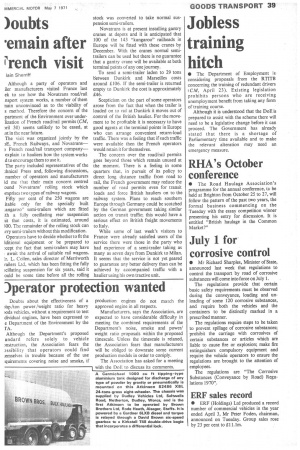)oubts vmain after i•encli visit
Page 41

If you've noticed an error in this article please click here to report it so we can fix it.
lain Sherriff
Although a party of operators and iler manufacturers visited France last ek to see how the Novatrans road/rail nsport system works, a number of them nain unconvinced as to the viability of s method. Therefore the concern of the ;partment of the Environment over underfization of French road/rail permits (CM, 30) seems unlikely to be eased, at Lst in the near future.
The visit was organized jointly by the aE, French Railways, and Novatrans:. French road/rail transport company— explain to hauliers how the system works d to encourage them to use it.
The party included representatives of the thnical Press and, following discussions, number of operators and manufacturers Id me that their main concern centred ound Novatrans' rolling stock which Imprises two types of railway wagons.
Fifty per cent of the 250 wagons are itable only for the specially built :angaroo" semi-trailers which are fitted ith a fully oscillating rear suspension tit that costs, it is estimated, around 100. The remainder of the rolling stock can irry semi-trailers without this modification. Operators have to decide whether to fit the lditional equipment or be prepared to :cept the fact that semi-trailers may have await the arrival of suitable rail wagons. fr. L. Collen, sales director of Merriworth railers Ltd, which has been fitting the fully ;cillating suspension for six years, said it ould be some time before all the rolling
stock was converted to take normal suspension semi-trailers.
Novatrans is at present installing gantry cranes at depots and it is anticipated that 100 of the 143 "kangaroo" railheads in Europe will be fitted with these cranes by December. With the cranes normal semitrailers can be used but there is no guarantee that a gantry crane will be available at both terminal points of any one journey.
To send a semi-trailer laden to 29 tons between Dunkirk and Marseilles costs around £106. If the semi-trailer is returned empty to Dunkirk the cost is approximately £46.
Scepticism on the part of some operators arose from the fact that when the trailer is loaded on to rail at Dunkirk it moves out of control of the British haulier. For the movement to be profitable it is necessary to have good agents at the terminal points in Europe who can arrange convenient return-load traffic. There was a feeling that if such traffic were available then the French operators would retain it for themselves.
The concern over the road/rail permits goes beyond those which remain unused at the moment. There is a feeling in some quarters that, in pursuit of its policy to direct long distance traffic from road to rail, the French government may reduce the number of road permits even for transit loads and force British hauliers on to the railway system. Plans to reach southern Europe through Germany could be scotched by the German government taking similar action on transit traffic; this would have a serious effect on British freight movements to Italy.
While some of last week's visitors to France were already satisfied users of the service there were those in the party who had experience of a semi-trailer taking as many as seven days from Dunkirk to Milan. It seems that the service is not yet geared to guarantee any better delivery than can be achieved by accompanied traffic with a haulier using his own tractive unit.










































































































































































































